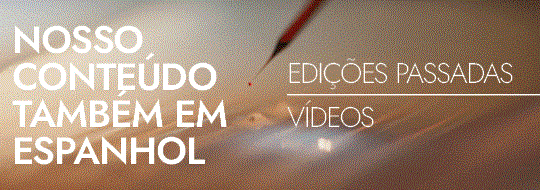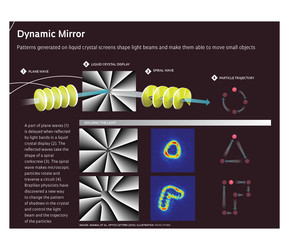The geometric figures projected by a laser beam in the laboratory of physicist Cid Bartolomeu de Araújo at the Federal University of Pernambuco (UFPE) may appear to be a trivial trick. However, these light patterns, only a few micrometers in size, are not made of simply any type of light; they are true whirls of light known as optical vortices. When they strike a microscopic object, such as a speck of dust or a living cell, these vortices cause the object to move and follow the shape of the projected figure continuouslyut there are many technological applications of optical vortices. Already used in physics and biology experiments to manipulate matter at the submicroscopic level, the vortices promise to increase the volume of information transmitted through optical fibers several hundred-fold. They can also serve as a basis for a new generation of optoelectronic circuits with nanometric dimensions. One advantage of the technique, developed by a trio of physicists at UFPE, is that it gives researchers and engineers the freedom to shape the optical vortices into the form they need for their applications.
This effect still may not seem significant, but there are many technological applications for optical vortices. While currently used in physics and biology experiments to manipulate matter at the submicroscopic level, the vortices could also potentially increase the volume of information transmitted through optical fibers by several hundred-fold. They could serve as a basis for a new generation of optoelectronic circuits with nanometric dimensions. One advantage of the technique, developed by a trio of physicists at UFPE, is to give researchers and engineers the freedom to shape the optical vortices into the form needed for their applications.
The techniques for creating optical vortices were first developed in the early 1990s by a group of physicists led by Les Allen and Han Woerdman at the University of Leiden in The Netherlands, who produced vortices that formed circular circuits. Vortices with other geometries have been obtained, but they were generated using more complicated techniques or techniques that generated only certain types of shapes. “We found a way to get any shape with the same experimental setup used to generate the circular vortices,” explains physicist Anderson Amaral, first author of the article describing the discovery published in the May 2013 issue of the journal Optics Letters).
Corkscrew
To produce an optical vortex, the researchers point a conventional laser beam at a liquid crystal screen. Before reaching the screen, the wave of light from the laser propagates as a series of plane wavefronts. When the wavefronts penetrate the liquid crystal, they are reflected according to the geometric pattern of light and dark bands created by rearranging the molecules of the computer-controlled liquid crystal screen. Dark areas reflect light instantly, while light bands delay reflection. Thus, the geometric pattern slows certain parts of the light wavefronts, resulting in the plane wavefronts taking on the shape of a corkscrew (see illustration).
When the spiral light beam is projected onto a wall, one sees a ring of light instead of a bright spot. The twisting of the wave cancels its intensity on the beam’s axis and creates a dark area at its center. At the same time, the remaining light ring gains the power to move particles or small objects sensitive to the subtle power of light. Thus, the particles affected by the beam travel the circuit formed by the ring. The greater the twisting of the light, that is, the shorter the distance between the turns of the corkscrew-shaped wave, as determined by the number of dark and light bands in the liquid crystal display, the faster the particles rotate.
Amaral began investigating ways to control the twisting of light last year when he started his Ph.D. under the supervision of Araújo and the physicist Edilson Falcão Filho, also at UFPE. Amaral’s objective was to use optical vortices to manipulate the electrons in a metal. Currently, electronic circuits cannot be smaller than a few micrometers (thousandths of a millimeter). However, many researchers are working to create circuits up to a thousand times smaller that would operate based on nanometric oscillations of electrons, called plasmons, created and controlled by special light beams, such as optical vortices.
Physicists from the state of Pernambuco explored a property of optical vortices called topological charge. Roughly speaking, this charge is a number that determines how many turns the light corkscrew possesses. “Everyone calls this quantity topological charge, but its topological [geometric] properties are rarely discussed,” says Amaral. Mathematicians state that two geometric figures have the same topology if one can be molded into the other without cutting or pasting their points. A sphere can be transformed into a cube using this technique, while a cup can generate a donut and vice versa. Similarly, the researchers noted that it would be possible to change the shape of the light vortices without changing their topology. In other words, the ring of light could take different shapes, the letter L, for example, and maintain the ability to transmit its rotation to a particle.
Circles and triangles
The novelty of the technique developed by Araújo’s team is the shaping of the vortex ring by changing the format in the center of the black and white pattern on the liquid crystal screen. In the article in Optics Letters, Araújo’s team demonstrated the technique by creating L-shaped vortices, elongated circles and triangles. “We are extending the technique to create more complex shapes,” says Araújo.
“This is a very efficient approach for molding optical vortices,” says Johannes Courtial, a physicist in Miles Padgett’s group at the University of Glasgow, Scotland, one of the most important groups studying optical vortices in the world. According to Courtial, the way the dark central portion of the vortex acts as a sort of mold for the bright part of the vortex is very interesting.
Although focused on the application of the vortices to plasmon circuits, the UFPE group believes the technique could also be useful in telecommunications. Current optical fibers carry messages simultaneously by means of laser beams of different wavelengths traveling together inside the fibers. The limit on information flow is on the order of 10 gigabits per second. An international group of engineers demonstrated in an article published June 28, 2013 in the journal Science that encoding information using optical vortices would expand this limit beyond a thousand gigabits per second. “This limit would increase even more if we could change the shape of the vortices,” explains Falcão Filho.
Scientific article
AMARAL, A.M. et al. Shaping optical beams with topological charge. Optics Letters. v. 38, n. 9. May 2013.

